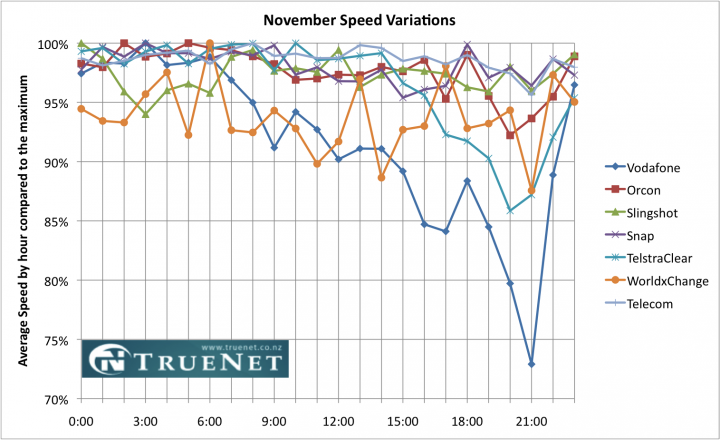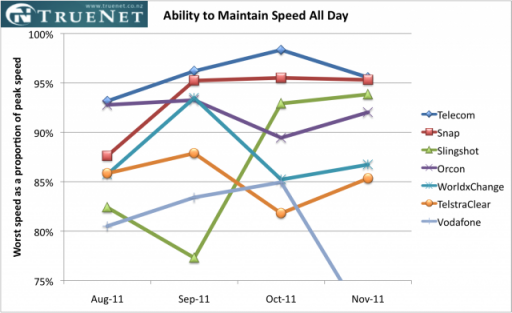Vodafone, TelstraClear respond to findings of peak time congestion
UPDATED with TelstraClear and Vodafone responses.
UPDATED with TelstraClear and Vodafone responses.
(UPDATE - See end of story for TelstraClear and Vodafone response.)
"Customers of Vodafone and TelstraClear already know that seven o'clock at night is the worst time of day to surf the net and TrueNet figures confirm this," the Telecommunications Users Association and testing company TrueNet said in a statmement this morning.
The report comes on the eve of a TelstraClear promotion that will see unmetered, all-you-can-eat internet this weekend, with its customers able to download as much as they like without impacting their data caps. Yesterday, the ISP warned the publicity stunt could cause some degree of slow-down.
Both fixed line operators suffer far more network congestion at peak times than their competitors, something TrueNet managing director John Butt suggests this is a significant congestion issue. The survey is carried out in partnership with Tuanz.
"We look at the variation between peak speed and the low point and with Vodafone the drop was most significant at 7pm - they fall to 75% of peak speeds," said Mr Butt.

Click to enlarge
TelstraClear's service (both on DSL and cable) also falls short at peak time - down to roughly 85% of peak speeds.
"Speed variations by time-of-day are often the consequence of design rules and growth rates. If design limits are too tight or unexpected growth places too much traffic into the capacity available, congestion occurs and speeds reduce," said Mr Butt.
Because time-of-day performance can vary wildly from month to month, TrueNet monitors which ISPs manage this issue the most reliably.

Click to enlarge.
Taken over a four month period the outcome is clear - customers' service can be adversely affected at peak times. This could pose challenges for TelstraClear's proposed "unlimited broadband”, says Tuanz chief executive Paul Brislen.
"It’s important that telcos work out how to give us far more data than we currently get, so from that point of view TelstraClear’s trial run of unlimited broadband is very good news. However we also need to make sure that current customers aren’t impacted by overloading," said Mr Brislen.
In July, TrueNet tested a similar experiment by Snap which found service levels coped well all weekend without noticeable impact.
TelstraClear takes issue
TelstraClear spokesman Gary Bowering took issue with the results.
"All ISPs have slowdown at certain times of day," Mr Bowering said.
"What matters to customers is the overall speed of browsing and overall network up-time. As TrueNet has shown in other testing, TelstraClear has the lowest web page load times."
TrueNet found TelstraClear's hybrid cable service, available in parts of Wellington and Christchurch, fastest in its most recent survey. TelstraClear's more widely available DSL service was seventh.
"The latest TrueNet figures are interesting but we don’t believe that they tell much about a customer’s actual browsing or Internet experience. We note that the figures show a percentage change rather than an overall speed for each ISP, which would be more meaningful. For example, 5% variation of an overall low speed still gives the user a low speed experience," Mr Bowering said.
"A 15% variation on a much higher quality Internet connection, such as our 25Mbit/s cable service, would still give that customer a better overall experience than someone on a slower connection that had less variation. The same principle applies to DSL services – it is the customer’s actual browsing experience that matters."
Vodafone surprised
"We are rather surprised by these results as daily testing from Epitiro, the independent broadband monitoring agency, shows Vodafone consistently in the top few providers in terms of throughput and speed," Vodafone chief networks officer Tony Baird told NBR.
"Vodafone also scored well in the last Truenet study in terms of speed and was recognised as having the greatest improvement overall."
Mr Baird also echoed TelstraClear's criticism of the way the data was presented.
"What Truenet has chosen to highlight doesn’t reflect the actual speed customers experience, merely the biggest variance. The statistics they focus on are percentage variations of peak speed to offpeak speed, not the actual speeds of each provider. For example, an ISP running at 20Mbit/s which then drops to 15Mbit/s at peak times will look to perform worse in Truenet’s graph than a provider running at 5Mbit/s whose speed drops to 4.5Mbit/s at peak times," Mr Baird said.
Sign up to get the latest stories and insights delivered to your inbox – free, every day.